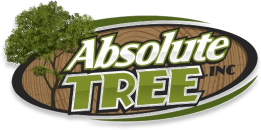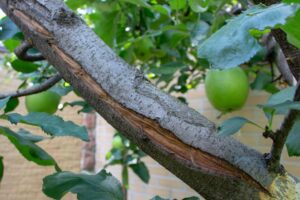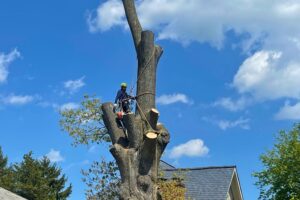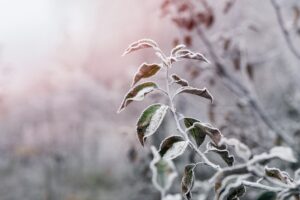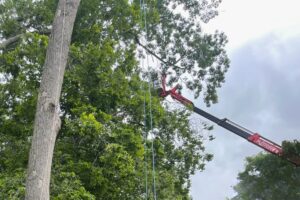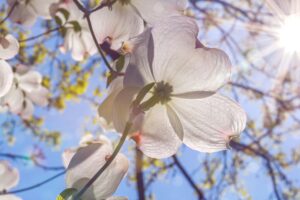After Tropical Storm Debby swept through Northern Virginia in August 2024, leaving damaged trees across Stafford and Loudoun counties, many homeowners in Great Falls, McLean, and Arlington realized they needed to better understand proper tree care. While emergency crews handled the storm cleanup, the aftermath highlighted an important truth: regular, proper pruning can help ornamental trees withstand severe weather and maintain their beauty year-round.
If you’re a Northern Virginia homeowner with ornamental trees like dogwoods, cherry trees, or crabapples, knowing how to prune them correctly isn’t just about keeping them attractive. It’s about keeping them healthy, safe, and resilient against the storms our region faces each year.
Key Takeaways
- Flowering dogwoods (Virginia’s state tree) should be pruned right after blooming, while most other ornamentals do best with late winter pruning.
- Sharp, clean tools prevent disease spread and ensure clean cuts that heal properly.
- Always remove Dead, Diseased, and Damaged wood before making any aesthetic cuts.
- Never remove more than 25% of a tree’s canopy in a single year, as this stresses the tree and invites problems.
- Large branches, trees near power lines, or complex structural issues require Certified Arborists for safety and tree health.
- Understanding where and how to make cuts prevents disease entry and encourages healthy regrowth.
Understanding Ornamental Trees in Northern Virginia
Northern Virginia’s diverse climate supports a wide variety of ornamental trees that provide year-round beauty to our landscapes, including:
- Flowering Dogwood (Cornus florida): Virginia’s state tree, known for spring blooms and fall color
- Ornamental Cherry: Including Yoshino and Kwanzan varieties popular in McLean and Great Falls
- Crabapple: Hardy trees that provide spring flowers and fall fruit
- Eastern Redbud: Native species with heart-shaped leaves and early spring blooms
- Ornamental Pear: Fast-growing trees common in newer developments
These trees require specific pruning to thrive in our humid subtropical climate with its hot summers and variable winters.
TIMING TIP FOR NORTHERN VIRGINIA: Most ornamental trees should be pruned during their dormant season (late winter to early spring) for best results. However, spring-blooming trees like dogwoods and ornamental cherries are exceptions – prune these immediately after flowering to avoid removing next year’s buds. According to the Virginia Cooperative Extension, this timing helps prevent disease issues and ensures maximum flowering the following season.
Understanding your specific tree species is important because each has different growth patterns and pruning needs. Dogwoods, for example, naturally develop a layered, horizontal branching structure that should be preserved, while crabapples tend to produce water sprouts that need regular removal. Learn more about caring for Virginia’s state tree in our comprehensive dogwood guide.
“In my 19 years serving Northern Virginia homeowners, I’ve seen the same pruning mistakes repeated in Alexandria, Fairfax, and Burke neighborhoods,” says Ashley Davis, owner of Absolute Tree Service. “The biggest issue is homeowners treating all ornamental trees the same way, when each species has specific needs for timing, technique, and frequency of pruning.”
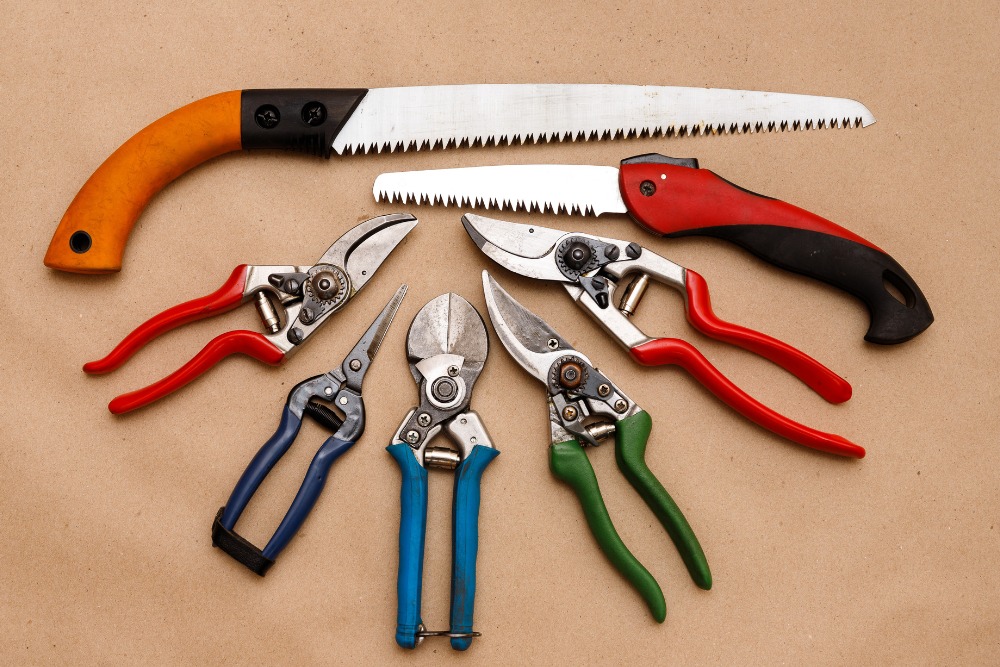
Having the right tools makes ornamental tree pruning safer and more effective.
Essential Tools and Preparation
Having the right tools makes pruning safer, more effective, and less stressful for both you and your trees. Quality tools also create clean cuts that heal properly, preventing disease and pest problems that can plague ornamental trees in our Virginia climate.
Must-Have Pruning Tools for Homeowners
For most ornamental tree pruning tasks, you’ll need:
- Hand Pruners (Bypass Style): For branches up to 3/4 inch diameter
- Loppers: For branches 3/4 inch to 1.5 inches diameter
- Pruning Saw: For branches larger than 1.5 inches
- Pole Pruner: For higher branches you can safely reach
- Disinfectant: Rubbing alcohol or 10% bleach solution to clean tools between cuts
Invest in quality tools with sharp blades. Dull tools crush and tear branches instead of making clean cuts, creating entry points for diseases that are common in Virginia’s humid climate.
Safety Equipment and Precautions
Before you make a single cut, make sure you’re equipped with the right safety gear to protect yourself while working around trees. Here’s what you’ll need:
- Safety Glasses: Protect your eyes from flying debris
- Work Gloves: Provide grip and protect your hands
- Hard Hat: Essential when working under trees
- Sturdy Ladder: Only if you can maintain three points of contact
Never attempt to prune branches near power lines or large branches that could fall on structures. These situations require professional equipment and expertise for safe removal.
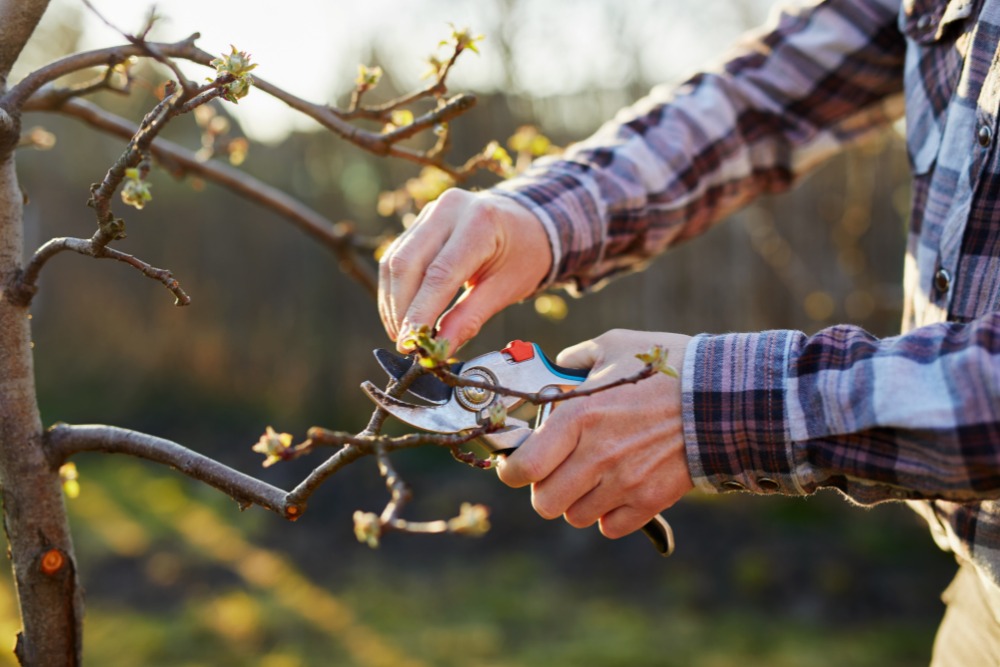
Proper cutting technique prevents disease and promotes healthy growth.
Step-by-Step Pruning Guide for Homeowners
Proper pruning follows a systematic approach that prioritizes tree health and safety. This step-by-step method works for most ornamental trees in Northern Virginia, though timing may vary by species as noted earlier.
Step 1: Tree Assessment Before Starting
Before making any cuts, walk around your tree and assess its overall health and structure. Look for:
- Dead, diseased, or damaged branches
- Branches that cross or rub against each other
- Water sprouts (vertical shoots growing from branches)
- Suckers (shoots growing from the base)
- Overall tree shape and any structural issues
Take photos from different angles to help you visualize the final result before you start cutting.
Step 2: Remove Dead, Diseased, and Damaged Wood
Start with the “Three D’s” – this is the most important step for tree health:
- Dead Branches: Remove completely back to healthy wood or the main trunk
- Diseased Branches: Cut back to healthy tissue, disinfecting tools between cuts
- Damaged Branches: Remove broken, cracked, or storm-damaged wood
PROPER CUTTING TECHNIQUE: Make cuts just outside the branch collar (the swollen area where the branch meets the trunk). This allows the tree to heal properly and prevents decay from entering the main trunk. The International Society of Arboriculture provides detailed guidelines on proper pruning cuts, emphasizing that correct technique is essential for tree health and longevity.
Step 3: Address Structural Issues
Next, focus on improving the tree’s structure:
- Remove Water Sprouts: These vertical shoots waste energy and crowd the canopy
- Eliminate Suckers: Cut shoots growing from the base back to the ground
- Address Crossing Branches: Remove the weaker of two branches that rub together
- Open The Center: Remove some interior branches to improve air circulation
Good air circulation is especially important in Virginia’s humid climate to prevent fungal diseases. For more information about seasonal pruning considerations, check our detailed timing guide.
Step 4: Shape for Health and Aesthetics
With health and structure addressed, you can make cuts to improve the tree’s appearance:
- Maintain Natural Form: Work with your tree’s natural growth pattern
- Remove Low Branches: If needed for clearance, but don’t over-lift the canopy
- Thin Selectively: Remove some branches to reduce density without changing the tree’s shape
- Make Heading Cuts Sparingly: Only when necessary to control size
Remember: never remove more than 25% of the canopy in one year. Over-pruning stresses trees and makes them more susceptible to diseases and pests.
Step 5: Clean Up and Aftercare
Proper cleanup prevents disease spread and helps your tree recover. Here’s what you should always do after pruning:
- Remove All Cut Branches: Don’t leave them around the tree base
- Clean And Disinfect Tools: Prevent spreading diseases to other plants
- Apply Mulch: A 2-3 inch layer helps retain moisture and suppress weeds
- Water If Needed: Newly pruned trees may need extra water during dry periods
Avoid applying tree wound dressing or paint – research shows these products can actually slow healing and trap moisture.
Common Homeowner Pruning Mistakes to Avoid
Even well-intentioned homeowners can damage their ornamental trees by making common pruning mistakes. Understanding these pitfalls helps you avoid costly problems that can take years to correct.
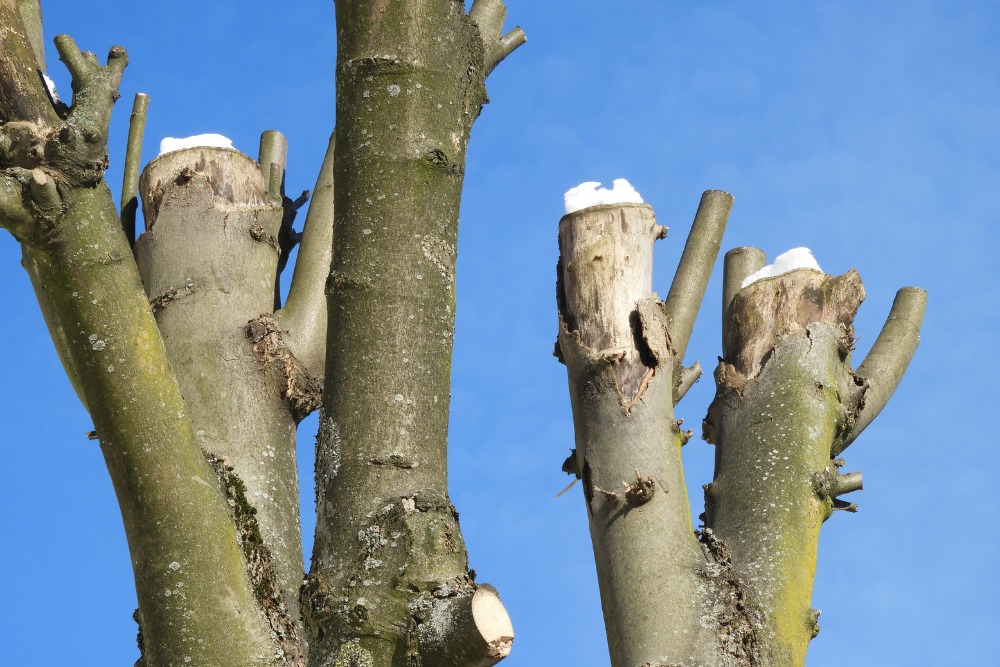
Avoid these common pruning mistakes that can permanently damage your ornamental trees.
Over-pruning and “Topping”
The most damaging mistake is removing too much of the tree at once. “Topping” – cutting back all branches to stubs – is particularly harmful and should never be done. According to the Virginia Department of Forestry, this practice:
- Removes the tree’s food-producing leaves
- Creates large wounds that invite decay
- Stimulates weak water sprout growth
- Makes trees more susceptible to storm damage
In Virginia’s climate, over-pruned trees often develop cankers and other diseases that can be fatal. Following proper pruning techniques that promote long-term tree health is essential to prevent these problems and maintain your ornamental trees’ beauty and structural integrity.
Wrong Timing for Species
Pruning at the wrong time can:
- Remove flower buds on spring-blooming trees
- Expose trees to diseases that are active during certain seasons
- Stimulate growth that won’t harden off before winter
- Attract insects to fresh wounds
For example, pruning dogwoods in late winter removes the flower buds that formed the previous fall, resulting in no blooms that spring.
Improper Cuts That Invite Disease
Poor cutting technique creates problems such as:
- Flush Cuts: Cutting too close to the trunk removes protective tissue
- Stub Cuts: Leaving stubs that die back and decay
- Torn Bark: Using dull tools or improper technique
- Angle Cuts: Cutting at wrong angles that shed water poorly
Virginia’s humid summers create ideal conditions for diseases to enter through improperly made cuts.
Ignoring Safety Concerns
Overlooking basic safety precautions can lead to serious injury or property damage. Here are some of the most common (and dangerous) mistakes to avoid:
- Using ladders on uneven ground
- Attempting to remove large branches without proper equipment
- Working near power lines
- Not wearing protective equipment
- Pruning during storms or high winds
After the storm damage we saw in Northern Virginia in 2024, many homeowners learned firsthand how dangerous tree work can be without proper training and equipment. For emergency situations, contact professional emergency tree services immediately.
Frequently Asked Questions
Do I need a permit to prune ornamental trees in Northern Virginia?
Generally, no permit is required for pruning ornamental trees on private property in most Northern Virginia municipalities. However, some homeowners associations have restrictions, and different rules may apply for street trees or trees in historic districts. Check with your local government and HOA before starting major pruning work.
How often should I prune my ornamental trees?
Most ornamental trees benefit from light pruning every 2-3 years, with annual inspection for dead or damaged wood. Young trees may need more frequent pruning to develop good structure, while mature trees typically need less frequent attention.
Can I prune my flowering dogwood myself?
Light pruning of small dogwoods is manageable for homeowners, but these trees are susceptible to diseases and require careful technique. For valuable or large dogwoods, consider having a Certified Arborist do the work, especially since timing is critical for maintaining blooms.
What’s the difference between pruning and trimming?
While the terms are often used interchangeably, pruning typically refers to the selective removal of branches for tree health and structure, while trimming often means cutting back growth for size control or aesthetics. Proper pruning considers the tree’s biology and long-term health.
When should I call a professional arborist?
Call a professional for branches over 4 inches in diameter, trees near power lines, trees showing signs of disease or structural problems, or anytime you’re unsure about the proper approach. Emergency situations after storms also require professional expertise.
How do I know if my pruning cuts are healing properly?
Properly made cuts should develop callus tissue around the edges within a growing season. Watch for signs of decay, unusual discoloration, or pest activity around cut areas. If you notice problems, consult with an arborist.
Trust the Experts for Healthy Ornamental Trees
While this guide provides the fundamentals of ornamental tree pruning, every tree and situation is unique. At Absolute Tree Service, our ISA Board Certified Master Arborist has helped Northern Virginia homeowners maintain beautiful, healthy ornamental trees for over 19 years.
Whether you need our comprehensive Arborist Assessment or professional pruning services, we provide expert guidance tailored to your trees and property.
Call Absolute Tree Service at 703-969-6207 or request an estimate online to ensure your ornamental trees receive the expert care they deserve.
For the Absolute Best Tree Service in Northern Virginia, call Absolute Tree Today!
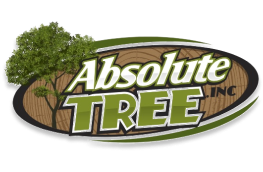
Author Profile: Ashley Davis
Over the last 19 years, Absolute Tree has grown a reputation as one of the premier tree service companies in the Northern Virginia areas. And there’s a good reason for this—we love trees and our passion for them shows. When you call on Absolute Tree for tree service, you aren’t just getting “some guys who cut down trees.” You’re hiring highly skilled arborists who understand the growth of trees and consider tree care an art form.
Stay Up-to-date!
Swing in each month for new articles, pest alerts, local resources, tree care tips, tree health updates, and landscape maintenance ideas
